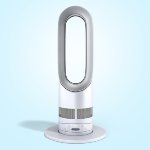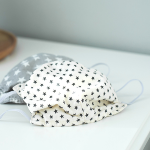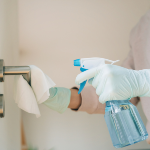 HAVE A QUESTION FOR DR. TESSA?
HAVE A QUESTION FOR DR. TESSA?
Email her your question at askdrtessa@ascpskincare.com.
 Q: My treatment room doesn’t have windows. What’s the best way to keep my space safely ventilated?
Q: My treatment room doesn’t have windows. What’s the best way to keep my space safely ventilated?
A: The stone-cold answer is that if either you or your client are infected with SARS-CoV-2 (the technical name of the novel 2019 coronavirus that causes the disease referred to as COVID-19), the risk of transmitting the virus via close contact for greater than 20 minutes in a windowless treatment room is high. Our understanding of how the coronavirus spreads is evolving, but the current thinking is that it travels via droplets expelled from the body through coughing, sneezing, talking, and breathing. While most of these droplets fall to the ground quickly, some research suggests smaller aerosolized particles may remain in the air longer. To mitigate the risk of transmission, consider reducing potential exposure from respiratory droplets and virus suspended in aerosols in the air and on surfaces.
Well-equipped hospitals that care for COVID patients have engineering controls that maintain negative pressure relative to the surrounding areas, and with a minimum of six air changes per hour (12 air changes per hour are recommended for new construction or renovation). Air from these rooms are ideally exhausted directly to the outside or filtered through a high-efficiency particulate air (HEPA) filter directly before recirculation. Hospital-grade air-handling systems (with appropriate directionality, filtration, exchange rate, etc.) that are properly installed and maintained by dedicated staff are not a reality for your treatment room, thus we cannot eliminate the risk.
However, there are four strategies to reduce or mitigate risk of viral transition:
 Open the treatment room door if possible. Simply leaving the door open will let in fresh air and help dilute indoor contaminants—including virus particles. Consider if there is a way to maintain privacy in the room while keeping the door open by using a curtain or barrier that still allows for airflow. Depending on your office layout and if you share your space with others, you can also place a fan in the doorway with the flow of air directed out of the room to create a bit of negative pressure.
Open the treatment room door if possible. Simply leaving the door open will let in fresh air and help dilute indoor contaminants—including virus particles. Consider if there is a way to maintain privacy in the room while keeping the door open by using a curtain or barrier that still allows for airflow. Depending on your office layout and if you share your space with others, you can also place a fan in the doorway with the flow of air directed out of the room to create a bit of negative pressure.
 Use a high-efficiency portable particulate air (HEPA) purifier in the room if closing the door is a must. HEPA air filters have not yet been proven to reduce the transmission of SARS-CoV-2, however recent research in the Journal of Infectious Diseases1 and BMC Infectious Diseases2 suggests they can reduce the risk of transmission to other viruses like measles and influenza. Thus, in theory, if an air purifier removes viruses from the air, it reduces concentrations in the room and the potential for exposure. HEPA filters are very effective, certified to capture 99.97 percent of particles that are precisely 0.3 micron in diameter. SARS-CoV-2 is smaller at 0.125 microns, but the droplets it usually travels in when people cough, talk, or breathe are larger—around 1 micron, a size easily captured by HEPA filters. The problem is that for the virus to be captured by the filter, the air needs to be circulated through it. This is why you would want to select an air purifier with a higher CADR (clean air delivery rate) number on the packaging (ideally over 240) and use it at its highest setting (which can be quite loud). Place the air filter away from anything that can obstruct airflow such as furniture or curtains. Consumer Reports3 did an article on HEPA air purifiers with a higher CADR rating, and identified some that were less than $2003.
Use a high-efficiency portable particulate air (HEPA) purifier in the room if closing the door is a must. HEPA air filters have not yet been proven to reduce the transmission of SARS-CoV-2, however recent research in the Journal of Infectious Diseases1 and BMC Infectious Diseases2 suggests they can reduce the risk of transmission to other viruses like measles and influenza. Thus, in theory, if an air purifier removes viruses from the air, it reduces concentrations in the room and the potential for exposure. HEPA filters are very effective, certified to capture 99.97 percent of particles that are precisely 0.3 micron in diameter. SARS-CoV-2 is smaller at 0.125 microns, but the droplets it usually travels in when people cough, talk, or breathe are larger—around 1 micron, a size easily captured by HEPA filters. The problem is that for the virus to be captured by the filter, the air needs to be circulated through it. This is why you would want to select an air purifier with a higher CADR (clean air delivery rate) number on the packaging (ideally over 240) and use it at its highest setting (which can be quite loud). Place the air filter away from anything that can obstruct airflow such as furniture or curtains. Consumer Reports3 did an article on HEPA air purifiers with a higher CADR rating, and identified some that were less than $2003.
 Wear face masks properly. If worn properly, a face mask helps block respiratory secretions produced by the wearer from contaminating other persons and surfaces. Important point: wearing a face mask reduces risk to your client, not you. If you have access to surgical face masks, these should be used once (a new one with each client) and then thrown away. Wash your hands with soap and water for 20 seconds before putting on the mask and after throwing it away. Surgical face masks are in short supply, and it is unlikely you will have easy, affordable access to them. Cloth face masks are recommended by the Centers for Disease Control and Prevention (CDC) to prevent the spread of SARS-CoV-2. Again, wash your hands before putting on the mask, leave it on during the entire treatment session without touching your face or the mask, remove it after the client has departed, and wash your hands. Just like the surgical face masks, the cloth mask should be considered a contaminated item; after you’ve said goodbye to your client, take it off and place it in a paper bag for laundering . Given that I’m recommending using a different cloth face mask for each client, you will need to have a reasonably large supply. It is my opinion that we should abandon the idea of the pretty face mask. No one looks good in a face mask. Like many people, I’ve been at home clumsily sewing ill-fitting face masks that evoke nose itching the entire time I have them on. I didn’t inherit my mother’s craft gene. (However, I scored this 10-pack of fabric masks at Target the other day that fit both me and my 7-year-old so comfortably that we can wear them for hours without discomfort.) Each night, you should launder the cloth masks with soap and hot water for reuse.
Wear face masks properly. If worn properly, a face mask helps block respiratory secretions produced by the wearer from contaminating other persons and surfaces. Important point: wearing a face mask reduces risk to your client, not you. If you have access to surgical face masks, these should be used once (a new one with each client) and then thrown away. Wash your hands with soap and water for 20 seconds before putting on the mask and after throwing it away. Surgical face masks are in short supply, and it is unlikely you will have easy, affordable access to them. Cloth face masks are recommended by the Centers for Disease Control and Prevention (CDC) to prevent the spread of SARS-CoV-2. Again, wash your hands before putting on the mask, leave it on during the entire treatment session without touching your face or the mask, remove it after the client has departed, and wash your hands. Just like the surgical face masks, the cloth mask should be considered a contaminated item; after you’ve said goodbye to your client, take it off and place it in a paper bag for laundering . Given that I’m recommending using a different cloth face mask for each client, you will need to have a reasonably large supply. It is my opinion that we should abandon the idea of the pretty face mask. No one looks good in a face mask. Like many people, I’ve been at home clumsily sewing ill-fitting face masks that evoke nose itching the entire time I have them on. I didn’t inherit my mother’s craft gene. (However, I scored this 10-pack of fabric masks at Target the other day that fit both me and my 7-year-old so comfortably that we can wear them for hours without discomfort.) Each night, you should launder the cloth masks with soap and hot water for reuse.
 Clean and disinfect. All surfaces (counters, chairs, doorknobs) and nondisposable equipment used for client services should be cleaned and disinfected between clients according to manufacturer’s instructions and facility policies. First, pre-clean using soap and water; then disinfect using an EPA-certified disinfectant.
Clean and disinfect. All surfaces (counters, chairs, doorknobs) and nondisposable equipment used for client services should be cleaned and disinfected between clients according to manufacturer’s instructions and facility policies. First, pre-clean using soap and water; then disinfect using an EPA-certified disinfectant.
Overall, I’m afraid that “windowless treatment room” and “safe” don’t really live in the same sentence with SARS-CoV-2. However, the four suggestions above should reduce exposure from respiratory droplets and virus suspended in aerosols in the air and on surfaces.
References:
- Karen Kormuth et al., “Influenza Virus Infectivity Is Retained in Aerosols and Droplets Independent of Relative Humidity,” Journal of Infectious Diseases 218, no. 5 (September 1, 2018): 739–47
- Parham Azini et al.,“Estimating the Nationwide Transmission Risk of Measles in US Schools and Impacts of Vaccination and Supplemental Infection Control Strategies,” BMC Infectious Diseases, accessed May 2020
- Perry Santanachote, “What You Need to Know About Air Purifiers and the Coronavirus,” Consumer Reports (May 5, 2020)
ASCP DISCLAIMER:
 Please be sure to always work within your scope of practice as determined by your state and to adhere to all local and federal rules and regulations regarding COVID-19 protocols. To learn more about returning to your practice or to access free resources to assist you with reopening, access the ASCP Back-to-Practice Guide!
Please be sure to always work within your scope of practice as determined by your state and to adhere to all local and federal rules and regulations regarding COVID-19 protocols. To learn more about returning to your practice or to access free resources to assist you with reopening, access the ASCP Back-to-Practice Guide!
 About the Author:
About the Author:
Dr. Tessa Crume is an Associate Professor in the Epidemiology Department at the Colorado School of Health at the University of Colorado Anschutz Medical Campus. Her research focuses on the development and utilization of public health surveillance systems to understand the burden of disease. She has been an academic researcher since 2011, before which she worked for a decade as an applied epidemiologist at the state and federal level, analyzing surveillance data and evaluating public health impact. Dr. Crume has taught the core epidemiology class at the Colorado School of Public Health for nine years.
HAVE A QUESTION FOR DR. TESSA?
Email her your question at askdrtessa@ascpskincare.com.
- Log in to post comments
 HAVE A QUESTION FOR DR. TESSA?
HAVE A QUESTION FOR DR. TESSA? Q: My treatment room doesn’t have windows. What’s the best way to keep my space safely ventilated?
Q: My treatment room doesn’t have windows. What’s the best way to keep my space safely ventilated? Open the treatment room door if possible. Simply leaving the door open will let in fresh air and help dilute indoor contaminants—including virus particles. Consider if there is a way to maintain privacy in the room while keeping the door open by using a curtain or barrier that still allows for airflow. Depending on your office layout and if you share your space with others, you can also place a fan in the doorway with the flow of air directed out of the room to create a bit of negative pressure.
Open the treatment room door if possible. Simply leaving the door open will let in fresh air and help dilute indoor contaminants—including virus particles. Consider if there is a way to maintain privacy in the room while keeping the door open by using a curtain or barrier that still allows for airflow. Depending on your office layout and if you share your space with others, you can also place a fan in the doorway with the flow of air directed out of the room to create a bit of negative pressure. Use a high-efficiency portable particulate air (HEPA) purifier in the room if closing the door is a must. HEPA air filters have not yet been proven to reduce the transmission of SARS-CoV-2, however recent research in the
Use a high-efficiency portable particulate air (HEPA) purifier in the room if closing the door is a must. HEPA air filters have not yet been proven to reduce the transmission of SARS-CoV-2, however recent research in the  Wear face masks properly. If worn properly, a face mask helps block respiratory secretions produced by the wearer from contaminating other persons and surfaces. Important point: wearing a face mask reduces risk to your client, not you. If you have access to surgical face masks, these should be used once (a new one with each client) and then thrown away. Wash your hands with soap and water for 20 seconds before putting on the mask and after throwing it away. Surgical face masks are in short supply, and it is unlikely you will have easy, affordable access to them. Cloth face masks are recommended by the Centers for Disease Control and Prevention (CDC) to
Wear face masks properly. If worn properly, a face mask helps block respiratory secretions produced by the wearer from contaminating other persons and surfaces. Important point: wearing a face mask reduces risk to your client, not you. If you have access to surgical face masks, these should be used once (a new one with each client) and then thrown away. Wash your hands with soap and water for 20 seconds before putting on the mask and after throwing it away. Surgical face masks are in short supply, and it is unlikely you will have easy, affordable access to them. Cloth face masks are recommended by the Centers for Disease Control and Prevention (CDC) to  Clean and disinfect. All surfaces (counters, chairs, doorknobs) and nondisposable equipment used for client services should be cleaned and disinfected between clients according to manufacturer’s instructions and facility policies. First, pre-clean using soap and water; then disinfect using an
Clean and disinfect. All surfaces (counters, chairs, doorknobs) and nondisposable equipment used for client services should be cleaned and disinfected between clients according to manufacturer’s instructions and facility policies. First, pre-clean using soap and water; then disinfect using an  About the Author:
About the Author: